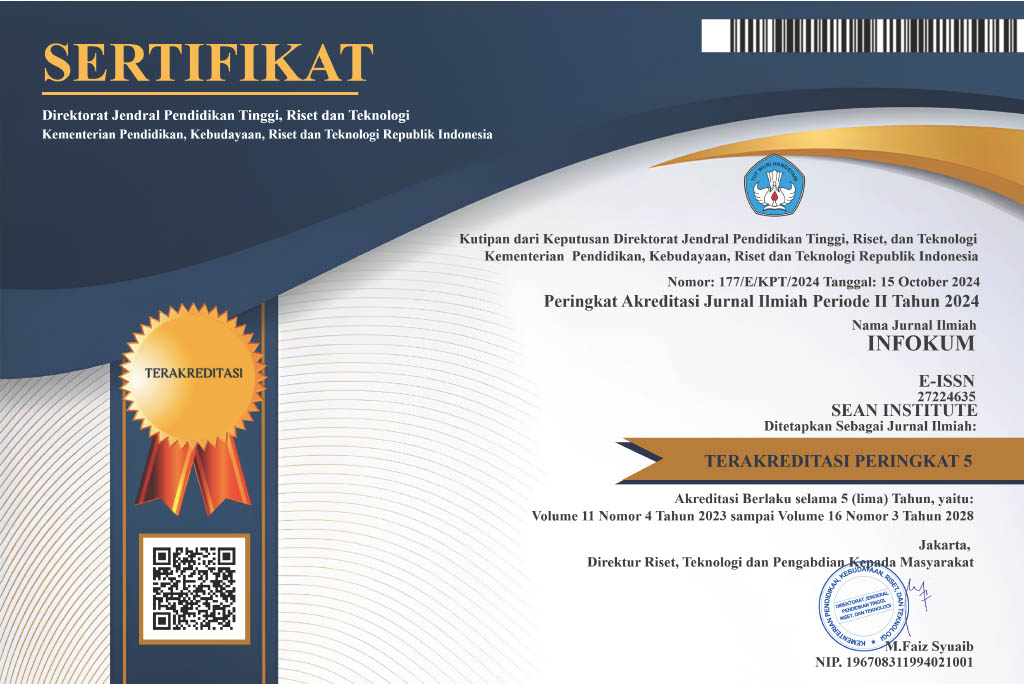Evaluation of the Implementation of the Smoke-Free Zone Policy in DKI Jakarta Province
Abstract
This study aims to analyze and evaluate the implementation of the Smoke-Free Area (KTR) policy in DKI Jakarta Province. The objectives of this study are to assess the extent to which this policy is implemented effectively and efficiently, and to identify factors that influence compliance with the policy in the field. This study uses Dunn's (2003) policy evaluation theory, which includes six main criteria: effectiveness, efficiency, adequacy, equity, responsiveness, and accuracy. The approach used in this study is descriptive qualitative, with data collection techniques through interviews, observation, and documentation. The results show that although this policy has shown some progress, such as increased public awareness of the importance of a smoke-free environment, significant challenges remain, particularly in terms of inconsistent law enforcement and low levels of compliance in several sectors, such as public transportation and public places. This evaluation also highlights the need for increased oversight, community engagement, and the provision of smoking facilities that meet standards. Furthermore, although resource management is quite good, increased budget and human resources are essential to strengthen policy implementation. This study proposes that the DKI Jakarta Provincial Government improve inter-agency coordination, strengthen oversight through technology, and expand educational campaigns to ensure the overall success of the KTR policy. In this regard, stricter law enforcement and continuous evaluation are key to achieving optimal policy objectives. This research contributes to our understanding of the implementation of the KTR policy in Jakarta and strategies for improving it for a healthier future.
Downloads
References
Arikunto, S. (2011). Prosedur Penelitian: Suatu Pendekatan Praktik, Edisi Revisi VII. Jakarta: PT. Rineka Cipta.
Badjuri, D., & Yuwono, A. (2002). Indikator Evaluasi Kebijakan Publik. Jakarta: Universitas Indonesia.
Best, J. W. (1959). Research in Education AB. United States of America.
Best, J. W. (2015). Research in Education, 10th Edition. Boston: Pearson Education.
Centre for Science and Technology Studies. (2025). VOSviewer: Visualizing Research Trends. Retrieved from https://www.vosviewer.com.
Creswell, J. W. (2014). Research Design: Qualitative, Quantitative, and Mixed Methods Approaches, 4th Edition. Thousand Oaks, CA: SAGE Publikations.
(2003). Evaluating Publik Policy. Boston: Pearson.
Dunn, William N. 2003. Pengantar Analisis Kebijakan Publik. Yogyakarta, Gadjah Mada University Press.
Esterberg, K. G. (2002). Qualitative Methods in Social Research. Boston: McGraw-Hill.
Hidayat, M. (2004). Metode Penelitian Deskriptif: Konsep dan Aplikasi. Jakarta: Rineka Cipta.
Judge, T. A., & Robbins, S. P. (2017). Essentials of Organizational Behavior. Pearson Education (US).
Labolo, M., Rowa, H., & Kawuryan, M. W. (2015). Dialektika Ilmu Pemerintahan (Kompilasi Hasil Seminar, Makalah dan Jurnal Ilmu Pemerintahan). Ghalia Indonesia.
Ndraha, T. (2005). Kybernologi I dan II. Jakarta: Rineka Cipta.
Ndraha, T. (2011). Kybernology (Ilmu Pemerintahan Baru). Rineka Cipta, Jakarta.
Nurcholis, M. (2005). Metodologi Evaluasi Kebijakan. Yogyakarta: Gadjah Mada University Press.
Nurcholis, Hanif. (2005). Teori dan Praktek Pemerintahan dan Otonomi Daerah. PT. Gramedia, Jakarta.
Supriyanto, B. (2009). Manajemen Pemerintah. Tangerang: CV. Media Berlian.
Syafiie, I. K. (2013). Pengantar Ilmu Pemerintahan.
Wahab, S. (2004). Evaluasi Program dan Kebijakan. Jakarta: Lembaga Penerbit Fakultas Ekonomi Universitas Indonesia.
Wahab, Solihin Abdul. (2004). Analisis Kebijaksanaan. Jakarta: Bumi Aksara.
Widjaja, S. (2005). Teori dan Praktik Pemerintahan. Jakarta: LP3ES.
Yin, R. K. (2003). Case Study Research: Design and Methods, 3rd Edition. Thousand Oaks, CA: SAGE Publikations.
Yuwono, A. & Badjuri, D. (2002). Indikator Evaluasi Kebijakan Publik. Jakarta: Universitas Indonesia.
Undang – Undang Nomor 36 Tahun 2009 tentang Kesehatan.
Peraturan Gubernur Nomor 88 Tahun 2010 tentang Kawasan Tanpa Rokok.
Peraturan Gubernur Nomo 40 Tahun 2020 tentang Kawasan Tanpa Rokok.
Organisasi Kesehatan Dunia (WHO). (2021). Tobacco Facts and Figures. World Health Organization. Retrieved from https://www.who.int
Badan Lingkungan Nasional (NEA). (2021). The Smoking Situation in Singapore. National Environment Agency, Singapore. Retrieved from https://www.nea.gov.sg
World Population Review. (2022). Countries with the Highest Percentage of Smokers in 2022. World Population Review. Retrieved from https://worldpopulationreview.com
Kementerian Kesehatan Republik Indonesia. (2021). Statistik Konsumsi Tembakau di Indonesia. Ministry of Health, Republik of Indonesia. Retrieved from https://www.kemkes.go.id
The World Bank. (2020). The Economics of Tobacco and the Tobacco Industry. The World Bank Group. Retrieved from https://www.worldbank.org
Asia Pacific Foundation of Canada. (2020). Global Tobacco Use and Publik Health Policies. Asia Pacific Foundation of Canada. Retrieved from https://www.asiapacific.ca









